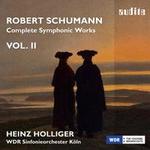|
Back
09/18/2014
Robert Schumann Complete Symphonic Works – Volume II
Robert Schumann: Symphony N° 2 in C major, Opus 61 – Symphony N° 3 in E-Flat major, Opus 97 (“Rhenish”) [*]
WDR Symphony Orchestra Cologne, Heinz Holliger (Conductor)
Recording: Cologne, Philharmonie (January 23-27 & March 19-23 [*], 2012) – 66’ 50
Audite # 97.678 – Booklet in German and English

   
Inside Robert Schumann lies a stalwart Romanticist: a verve for poetry and composition, translating into fiercely individualistic musical lines, passionate, feisty and resonating with a rebellious nature. So we turn to this CD, this, the second of symphonic recordings by maestro Heinz Holliger who has keen determination by reaching into the inner, turbulent soul of the Saxony-born composer.
Completing Robert Schumann’s symphonic cycles, here we have a splendidly itchy recording, initiated with pulsating, irritant rhythms in the opening “Sostenuto assai – Allegro ma non troppo” found in the Symphony N° 2. The horns’ entrée reigns like a pious Bach-like fugue that quickly leads into the hammering resonances of underlying strings, harkening back to Beethoven’s tempestuous flammability. Ensuing is a concise run of strings in the “Scherzo” which has Mendelssohn proportions, aberrantly akin to the aforementioned composer’s rendition of the “Scherzo” found within A Midsummer Night's Dream. Schumann places his own creative plaque upon the notes that Hollinger unhesitatingly jumps into with nonstop breezes of delight. Hollinger honors Schumann by positioning the exact number of orchestral members as originally prescribed by the composer.
The softened section, “Adagio espressivo”, positions Hollinger with proportionate dynamics and relates greatly back to Johannes Brahms in lucid demeanor. This selection is delicately rendered appropriately: strings shine, woodwinds shimmer in the upper notes. The conclusive “Allegro molto vivace” tugs and brims with abbreviated Mendelssohnian vivacity with rarefied diction. Schumann’s religious majesty quickly pops and declines with dignified substance until the portion’s dramatic resolve. Sublime.
Inside Schumann’s orchestral penultimate work, the Symphony N° 3 in E-Flat major, The “Lebhaft” unveils a confident, almost optimistic expanse, much in alignment with Beethoven, outlying the confident musical thread of what is greatly described as being a so called “Painting of the Rhine River”, the famed aqueous solution found deep within Germanic confines. Heinz Holliger continues to deliver consistent pulsations. Immediately following we hear similar musical paraphrases that Schumann likely drew inspirationally from Beethoven’s Pastoral Symphony, specifically the third movement, “Allegro” (“Lustiges Zusammensein der Landleute”), yet the piece conjures a flair of idyllic independent proportion. Contrasting with the latter, the “Nicht schnell” has a politesse vierge. Pauses and clauses are meaningful and determined, accentuating Schumann’s fortitude within this composition. The movement is a graceful connect inside the work.
We reminisce back to the opening movement which is found inside the “Feierlich” that retains its own degree of softened pomp with Holliger’s pronounced brass royalty. The declaration is concise, emphatic, yet terminally foreboding. Hopeful overtures are broadly expanded within Schumann’s mindset in the “Lebhaft” which seethes with Beethoven once again. Yes, once again, the movement is coherent and broadly cheerful as performed by the WDR Sinfonieorchester Köln. Despite a tumultuous life, Robert Schumann resolves to close this piece with a truly hopeful stance, a crowning glory to his orchestral works.
This Audite collection is grand and resolute in its interpretation of Schumann’s lively works.
Recommended.
Christie Grimstad
|